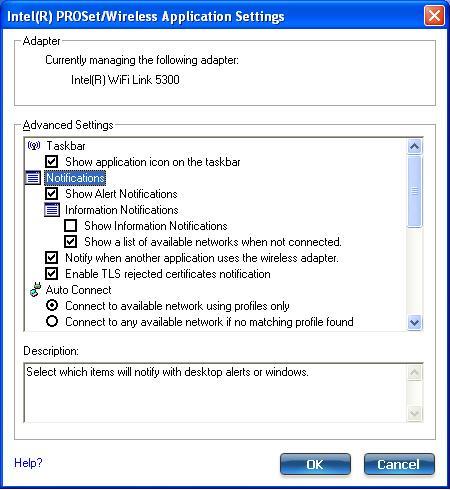

The Application Settings control the behavior of the Intel(R) PROSet/Wireless WiFi Connection Utility.
| Name | Description |
|---|---|
Adapter |
Lists the WiFi adapter. It may be any one of the following:
|
Advanced Settings: The following settings control how the WiFi connection utility behaves and displays information. |
|
Show icon on the taskbar: Select to display the Taskbar status icon. This icon resides on the Windows Taskbar (Notification Area). This icon provides the status of your wireless connection. Clear to not display the Taskbar status icon. The Taskbar Status Icon provides several functions:
|
|
Show Alert Notifications: Select to display desktop alerts next to the taskbar icon. When your action is required, a message displays. Only events of high importance trigger a desktop alert. If the desktop alert is selected, then the appropriate action is taken. Clear to not display desktop alerts. See Tool Tips and Desktop Alerts for more information. Select one of the following options: Information Notifications: These desktop alerts are of lower importance. They do not require your interaction but can greatly improve the wireless experience.
Notify when another application uses the WiFi adapter: When selected, a message is displayed when other applications are trying to manage your WiFi adapter. This is helpful if you use software provided by a hotspot location (coffee shop, airport terminal). To take advantage of the WiFi connection utility features, disable this software when you leave the hotspot. Enable TLS rejected certificates notification: Select if you want a warning issued when a PEAP-TLS certificate is rejected by the authentication server. See Enterprise Security and Set up a Client with TLS Network Authentication for more information. |
|
Connect to available network using profiles only: (Default) Connect the WiFi adapter to an available network with a matching profile from the Profiles List. If no matching profile is found, you are notified (see Notifications). The wireless device remains disconnected until a matching profile is found or you configure a new matching profile. Connect to any available network if no matching profile found: Select to connect to a network automatically if you have not configured a profile and are at a location that has an open, unsecured wireless network. NOTE: Open networks have no security. You would need to provide your own security for this wireless connection. One way to secure an open wireless connection is with Virtual Private Networking (VPN) software. Connect to any network based on profiles only (Cisco mode): Select to try every profile in preferred order. This signifies that you are in the vicinity of an access point which has more than one SSID but only advertises one. Do not automatically connect. User will connect manually: Select to turn off automatic connection. |
|
Enable automatic exclude list feature: Select to enable the automatic exclude list feature. This feature provides a way to exclude access points from automatic connection. See Manage Exclusions for more information. Enable manual exclude list feature: Select to enable the manual exclude list feature. This feature provides a way to exclude networks from automatic connection. See Manage Exclusions for more information. |
|
Show column sort headers: Select to display the column names in the WiFi Networks list. Click a column header to sort the column in either ascending or descending order. |
|
File and printer sharing enables other computers on a network to access resources on your computer. You should be cautious when you use your wireless notebook computer with file and printer sharing enabled. Use this feature to receive notifications when you connect to a wireless network with shared folders that meet one of the following conditions:
Unshare shared folders automatically when connected to an unsecured network. Disable this notification Notify when connected to an unsecured network. |
|
Receive alerts dependent on the following settings when connected to an ad hoc network. You are alerted every two minutes, with a maximum of five alerts. Notify when no peers have joined the ad hoc network Notify when all peers leave the ad hoc network |
|
Notifies you when the default network name (SSID) is used to connect to a network. Common examples of pre-defined, default network names are: wireless, WLAN, linksys, default. Connecting to an access point that has the default network name (SSID) can be a security problem. This access point usually uses all the default security and, management settings (for example, Open authentication; default IP address, user name, or password). If this is a personal network, change the network name and security settings to improve the security of the network. Notify when connected to a network with the default SSID name |
|
| WiFi Settings | Disable WiFi scanning when associated: This setting disables scanning for additional WiFi access points after the adapter connects to an access point (network). Disabling scanning when already connected can improve the connection performance. |
| Wi-Fi Protected Setup* | Enable device registration Turn Enable device registration off to let the computer detect and connect to a network as an enrollee. Notify when Wi-Fi Protected Setup access points are within range |
OK |
Saves settings and return to the previous page. |
Cancel |
Closes and cancels changes. |
Help? |
Provides help information for this page. |